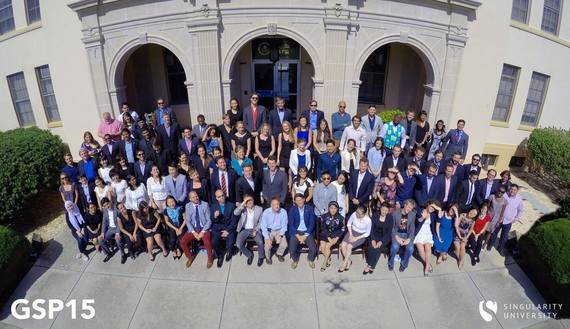My first words on Singularity University
When I first heard about Singularity University's Graduate Studies Program, I formed two theories about the near-future:
1.) if I got in, I would love it;
2.) it would be a long shot to get in.
Theory 2 was not meant to be critical or even a self-assessment, though my background as a social entrepreneur and sociologist seemed like it would be rather different than at least the plurality of other participants.
Rather, I saw the Graduate Studies Program (GSP) as a long shot because, in many ways, it is. The numbers are austere: 5000+ applicants. 80 spots. First year ever that the program was free for everyone - previously $30,000 - thanks to Google and other partners. Held at NASA Ames Research Center. And brimming with brilliant participants representing 40+ countries.
A long shot for me and anyone, really.
And therein lies a conundrum that, as I now see, the GSP is built to solve: desirable future outcomes are only unlikely insofar as they are not pursued. In the past, and in this situation certainly, what I perceived as realistic was calcified early on in my mind, rather than what could be.
This pessimism almost resulted in a self-fulfilling prophecy: I hemmed and hawed and hemmed some more until I suddenly realized that I was only two days away from the application deadline.
At the time, my rational brain concluded that any application I threw together in < 48 hours would not pass muster. So I missed the deadline, and relegated the idea of Singularity University to a distant, fuzzy future that I would somehow stumble into but certainly not proactively create.
Fortunately, a friend who had attended an earlier cohort reached out to ask me how my application turned out and, upon hearing that I hadn't hit "submit," informed me that the deadline had been extended two weeks.
The rest is history. I jumped into action, managed to corral two very generous references (thank you again, Luke and Erhardt), and got in. And so the first lesson of #GSP15 began before the program start date: it is incumbent upon us to accelerate the future, today in the present.
Ever hear the story of the young scientist who went for a walk and left the bunsen burner on, only to return to find a particle accelerator on her desk?
Me neither.
At any given point on the above exponential curve for DNA sequencing costs, we are unlikely to see our trajectory as the exponential line (blue line) and instead we see the linear lines (red and green lines) as the expected future. However, the future is less predictable than it seems, given accelerating, compounding advances. Therefore, what seems impossible is often our short-sightedness missing the trends behind the trends (e.g., Moore's Law) that profoundly shape our world.
Long shots are actually too easy. Time to embrace what Peter Diamandis calls moonshot thinking.
The reasonable man adapts himself to the world: the unreasonable one persists in trying to adapt the world to himself. Therefore all progress depends on the unreasonable man.
Here's to the unreasonable person.
To stay abreast of my latest writings on Singularity University, visit my blog at http://kevinfadler.com/blog.


